
Before the release of new products in the previous two days, the parade-free warm-up activities brushed up my circle of friends and various QQ groups. The speculative speculation of various kinds of brain boreholes made me realize that one problem: most people simply do not know micro-projections. The development of the situation, so I wrote this article on simple data.
  
Micro-projection is a display device that has been hot for the past two years. Various types of mobile phone projections and non-screen TVs have appeared in an endless stream. This self-proclaimed 300-inch device, which claims to be 3,000 lumens, is basically a manufacturer's chaos. This time I used the official document of DLP (Digital Light Processing) chip maker Texas Instruments to analyze these products briefly. Knowing these basic rules, I knew the true strength of micro-projections.
  
Anyone who knows a little about projection knowledge knows that the core technology of micro-projection is in the hands of Texas Instruments (Ti), which has long been publicized. It's as if the computer makers are tossing around, and it will always be limited to the chipsets and CPUs that Intel releases.
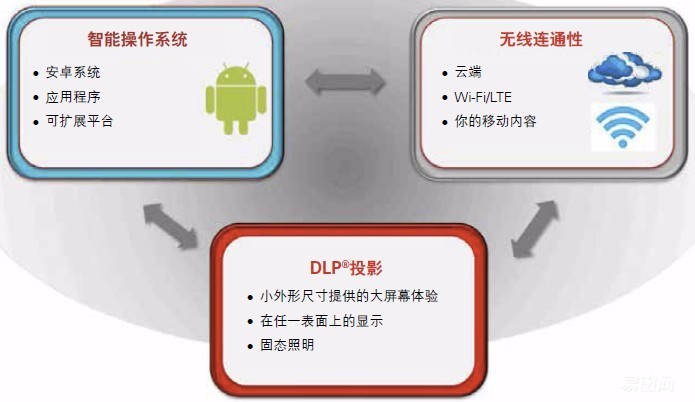
At present, all the micro-projection frameworks come from Ti's concept of “non-screen displayâ€, including the name of no-screen TVs from TI. No screen display integrates DLP Pico (microchip) technology, wireless connectivity and smart operating system three parts of the function, of which the most important DLP projection is Ti's exclusive technology, and the other two parts add up is now the popular Android box class product.
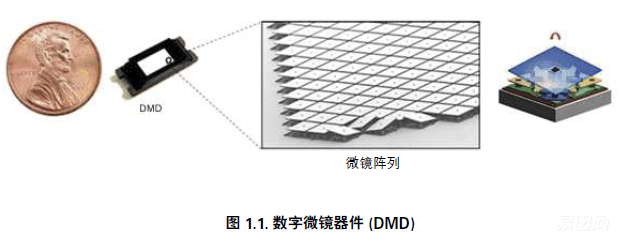
The core of DLP Pico is Ti's black technology: Digital Micromirror Devices (DMD). Nowadays, most of the miniaturized projectors use DLP technology, not just micro-projections. We all know that the liquid crystal is transparent, and the light source behind it lets us see the picture. The DMD is completely different. It is composed of countless small mirrors. Each pixel is a small mirror that can be rotated and displays light by reflecting light. Transmission will inevitably have a loss of light, and the line driving each pixel is not transparent, and it will also cause some areas to be opaque, so the efficiency of the liquid crystal is low, and the way of reflection can make the mirror cover the entire area and drive the circuit. All hidden behind the mirror, the efficiency will be much higher than the liquid crystal.
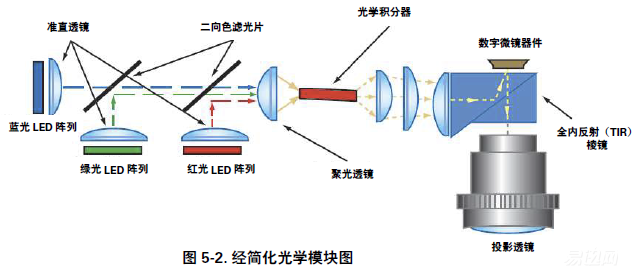
The biggest difference between micro-projection and traditional bulb projection is the light source. Traditional light bulbs can only emit white light. Colors can be achieved by separating three primary colors from the color wheel. LED light is originally monochromatic, and RGB light sources are used to achieve color effects. LED's luminous efficiency is higher than the light bulb, energy saving has a great advantage, but the highest brightness that can be achieved is still far lower than the light bulb, so it can only be used to do "micro-investment."
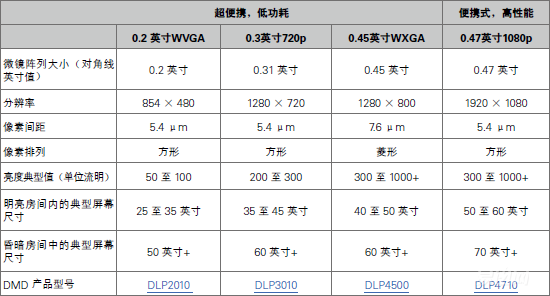
Micro-projection is definitely small in size as its name suggests, and the DMD chips used are all Ti-designed small-size products, ranging from 0.2 inches to the latest 0.47 inches. The above figure clearly lists the specifications of the four chips. All micro-projections will not exceed this form. The chip size not only limits the resolution, but also limits the maximum brightness. After all, light is also an energy, and the higher the concentration, the higher the temperature.
  
0.2-inch chip only 480p resolution, brightness 50-100lm, usually used in mobile phones, flat-panel built-in projection, the more popular PAPA projection is used this chip, there are some mobile phones, flat-panel integrated projection is this chip, For example, Lenovo's YOGA Tab pro3.
Built-in lithium-powered 720p models basically use a 0.3-inch 720p chip, such as a small meter of rice, Z4air, nuts P2, etc., and its brightness is 200-300lm (lm: lumens, that is luminous flux).
The 0.45-inch chip is currently the mainstream of high-end micro-projection, with a resolution of 1,280,800, which is the 720p specification of 16:10. Although the brightness is allowed to exceed 1,000, most products only have a brightness of around 600.
The 0.47-inch is the only 1080p chip currently used for micro-projection. It was released at the end of 2014. Formal sales should be mid-year, and this year will inevitably shine. This is exactly what H1 will use, so the basic specifications will come out: 1080p resolution, brightness of around 1000, and the other part is the size of an Android box.
  
From here you can see that all brands are similar situations. For example, although the pole meter has a lot of derivative models on the Z4, but the core part has not changed, Xiaoyan, Z4ari, and Jue are all the same 0.3-inch chips, while the Z4x and Z4 Aurora are 0.45-inch chips, just in the accessories and The software function has made some fine adjustments and adjusted the size of the lower ROM.
  
Of course Ti also has larger chips, such as 0.65/0.9 inch 1080p chips, 0.67 inch 4K chips (2K physical pixel jitter), and 1.4 inch 4K chips for commercial theaters. Large chips must have lens support of corresponding size, so the cost and volume are difficult to reduce, plus the brightness LED can achieve is limited, usually manufacturers are used in the bulb projection. However, there are exceptions, such as LG's LED projection PF80 uses a 0.65-inch 1080p chip, of course, the size will be larger than the ordinary micro-projection, starting price as high as 30,000, while the latest PF1500 although using 0.47-inch chip, but the brightness reaches 1400 lumens, priced at 1,000 US dollars.
  
See here you believe that you already have a clear idea of ​​micro-projection.
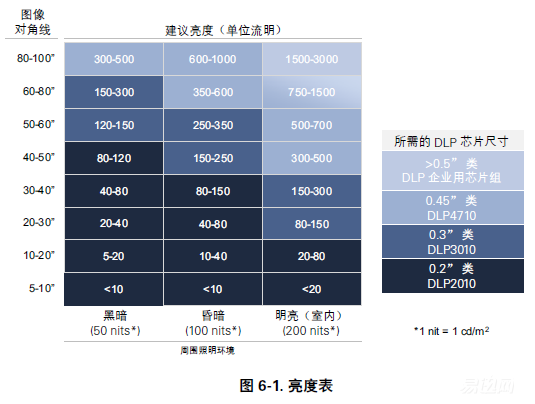
Shun brings to see the brightness and projection size suggested by Ti. This is related to the ambient brightness. If the light installed in the home is bright, it can reach about 150 nits. There are only less than 80 old dim old houses. You can refer to the following table.
  
For example, I use the Z4air brightness of 250, my family is a horizontal 3 G4 lamp beads chandelier, the brightness of the night when the lights are only about 60nits, corresponding to this table can be cast in about 60-80 inches, the measured 80-inch really can achieve good The effect of the size is no longer big picture. As for the Z4X 600 lumens, it is enough to invest 100 inches in a dim environment. I would like to cast a 300-inch spot in order to meet the viewing requirements.
  
There is a serious false propaganda about brightness, such as LED projection brightness is equivalent to 6 times the bulb projection, and some people even say that ANSI (American National Standard) projection brightness is equivalent to 6 times of ISO brightness. This is a lack of common sense, ANSI brightness detection requirements lower than ISO, usually higher than the ISO brightness value. Any projected luminance unit is an objective value, and there is no equivalent concept, and the source of this argument should be Epson's "color lumens." Monolithic DLP projection will have a higher white brightness than color brightness, but usually only about 40% of the error. It is definitely not 6 times as outrageous. The detailed principle will be explained in detail.

Finally talk about the price, the picture above is Jingdong several 1080p bulb projection price, if there is a coupon or discount will be lower when the 4000 or so to buy a 1080p 3000 brightness machine is the starting price of conventional projection, 4000 or less optional There are few licensed projectors for light bulb projections, but sea scouring can reach a minimum of around 3100.
  
Until Z4x's price of 2999, I think the price of rice is pretty good. It is very practical to replace horizontal TV. I recommended it to many friends and I bought it very well. However, since the beginning of 3999 Aurora, I have felt that the pricing is high. Although Aurora has added a trapezoidal correction chip to achieve left and right trapezoidal corrections, this function is generally applicable. There is no difference between the core projection part and the Z4x, but it costs 1,000 yuan more. The key is that this price can already buy 1080p light bulb projection, brightness will be more practical in all aspects, 2kg weight is not troublesome, I really can not think of the reason to choose Aurora.
  
The price of the H1 4999 is really a bit high, and it also exceeds the size of a small bulb projection. Unless both portable and 100-inch are required, I would not recommend it. As for micro-casting, I personally recommend the built-in lithium battery. At least, Ti has not released a 0.3-inch chip with a higher specification. It can guarantee that there will be no substitute in one or two years. As for the nuts, the 0.3-inch P2 is sold for 2999, and there are feelings on it.